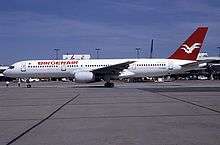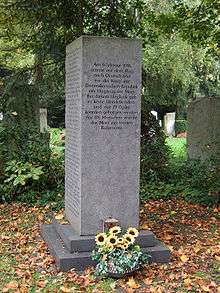Birgenair Flight 301
 TC-GEN, the aircraft involved in the accident seen at Schönefeld Airport in July 1995 | |
| Accident summary | |
|---|---|
| Date | 6 February 1996 |
| Summary | Blocked speed sensor leading to autopilot and pilot error |
| Site |
26 km (14 nmi) NE of Puerto Plata, Dominican Republic 19°54′50″N 70°24′20″W / 19.91389°N 70.40556°WCoordinates: 19°54′50″N 70°24′20″W / 19.91389°N 70.40556°W |
| Passengers | 176 |
| Crew | 13 |
| Fatalities | 189 (all) |
| Survivors | 0 |
| Aircraft type | Boeing 757-225 |
| Operator | Birgenair |
| Registration | TC-GEN |
| Flight origin |
Gregorio Luperón Int'l Airport Puerto Plata, Dominican Republic |
| 1st stopover |
Gander International Airport Gander, Newfoundland and Labrador, Canada |
| 2nd stopover |
Berlin Schönefeld Airport Berlin, Germany |
| Destination |
Frankfurt Airport Frankfurt, Germany |
Birgenair Flight 301 was a flight chartered by Turkish-managed Birgenair partner Alas Nacionales from Puerto Plata in the Dominican Republic to Frankfurt, Germany, via Gander, Canada, and Berlin, Germany. On 6 February 1996, the Boeing 757–225 operating the route crashed shortly after take-off from Puerto Plata's Gregorio Luperón International Airport.[1][2] There were no survivors. The cause was a pitot tube that investigators believe was blocked by a wasp nest that was built inside it. The aircraft had sat unused for some time without the required pitot tube covers in place.
Passengers and crew
The crew consisted of 11 Turks and 2 Dominicans. The captain was Ahmet Erdem (62), one of Birgenair's most senior pilots, with 24,750 flight hours under his belt. The first officer was Aykut Gergin (34). He had 3,500 hours of flying experience. The relief pilot was Muhlis Evrenesoğlu (51). He had 15,000 flight hours to his credit.
The passengers consisted mainly of Germans, along with a few Poles including two Members of Parliament, Zbigniew Gorzelańczyk (SLD), and Marek Wielgus (BBWR).[2][3] Most passengers had booked Caribbean package holidays with Öger Tours; Birgenair held 10% of Öger Tours.[4] In terms of passenger deaths, Flight 301 has the highest death toll of any aviation accident involving a Boeing 757.[5]
| Nationality | Passengers | Crew | Total |
|---|---|---|---|
| 167 | 0 | 167 | |
| 9 | 0 | 9 | |
| 0 | 11 | 11 | |
| 0 | 2 | 2 | |
| Total | 176 | 13 | 189 |
Crash
During takeoff roll at 11:42 p.m, the captain found that his air speed indicator (ASI) was not working properly, but chose not to abort takeoff.[6] The co-pilot's ASI was functional.
While the plane was climbing through 4,700 feet (1,400 m), the captain's airspeed indicator read 350 knots (650 km/h). The autopilot, which was taking its air speed information from the same equipment that was providing faulty readings to the captain's ASI, increased the pitch-up attitude and reduced power to lower the plane's airspeed. The co-pilot's ASI read 200 knots (370 km/h) and decreasing, yet the aircraft started to give multiple contradictory warnings that it was flying too fast, including rudder ratio, Mach airspeed, and overspeed lights and sounds.
The autopilot reached the limits of its programming and disengaged. After checking their circuit breakers for the source of the warnings, the crew then reduced thrust to lower the speed. This immediately triggered the 757's stick-shaker stall alert, warning the confused pilots that the aircraft was flying dangerously slow, seconds after it was warning them that the speed was too high. The co-pilot and the relief pilot Muhlis Evrenesoğlu both seemed to recognise the approaching stall and tried to tell the captain, but did not intervene directly, possibly out of deference to the captain's age and experience. The captain then tried to recover from the stall by increasing the plane's thrust to full, but the plane was still in a nose up attitude, preventing the engines from receiving adequate airflow to match the increase in thrust. The left engine flamed out, which caused the right engine, still at full power, to throw the aircraft into a spin. Moments later, the plane inverted.[7] At 11:47 p.m., the Ground Proximity Warning System sounded an audio warning, and eight seconds later the plane crashed into the Atlantic Ocean. All 13 crew members and 176 passengers were killed.
Investigation and final report
The Dominican Republic government's Dirección General de Aeronáutica Civil (DGAC) investigated the accident and determined the following probable cause for the accident:[8]
"The crew's failure to recognize the activation of the stick shaker as a warning of imminent entrance to the stall, and the failure of the crew to execute the procedures for recovery from the onset of loss of control."
Investigations later showed that the plane was actually travelling at 220 knots (410 km/h) at the time. The investigation concluded that one of three pitot tubes, used to measure airspeed, was blocked.
No tubes were recovered so investigators were unable to determine for certain what caused the blockage. Investigators believe that the most likely culprit was the black and yellow mud dauber, a type of solitary sphecid wasp well-known to Dominican pilots, which tends to establish its nest in artificial, cylindrical structures, or make its own cylindrical nest out of mud. According to the final report, section 2.3 - "Aircraft maintenance factors", the aircraft had not flown in 20 days, however, this was not the duration for which pitots remained uncovered, but was evidently enough time to allow the wasps the opportunity to construct nests in the tubes.[9][10]
Later, Birgenair refuted section 2.3 of the final report, regarding the proper maintenance procedure in Puerto Plata. According to Birgenair, "the aircraft was not on the ground for 20 days, but only for 12 days prior to the ill-fated flight. The pitot-tubes were covered prior to an engine test run which took place 2 days prior to the ill-fated flight. It was known by the BIRGENAIR mechanics that the airplane should be returned to Turkey in a ferry flight within the next 3 days. If therefore the pitot-tubes had not been covered after the engine test run for 2 days, according to the BOEING procedures, set forth in the BOEING Maintenance Manual, this might be justified."[11]
Birgenair further stated: "Despite these irritating and even conflicting procedures set forth in BOEING's 757 Maintenance Manual and the Maintenance Planning Document, a blockage of the pitot-tube might occur even within any period of stay on the ground and should therefore be clearly required for all periods of stay on the ground. [sic]"[11]

Aftermath
While the crash was attributed to the failure of the crew to execute the procedures for recovery, there were a number of incidental lessons learned.
The pilot's choice to go against protocol and execute takeoff despite his ASI clearly disagreeing with the co-pilot's ASI has resulted in protocols and training being further reinforced following this incident.
After the flight voice recorder revealed that the co-pilot and a third pilot on the flight deck had made relatively subtle suggestions to the pilot – once the stick-shaker warning commenced – that he must deal with the fact that the plane was still in a speed-draining nose-up attitude, protocols and training were reinforced to establish a greater willingness of junior flight-deck staff to be more forceful in similar situations. (In the Birgenair crash, it had even been revealed that the co-pilot chose not to use his own, active, stick to counter the pilot and try to bring the nose down.)
Later the same year (1996), Aeroperú Flight 603, also operated with a Boeing 757, suffered a similar but far more difficult situation (static ports blocked by tape, rendering all airspeed indicators and pressure altimeters unusable) and crashed in the ocean off Peru.[12]
Birgenair went bankrupt some months later as there were concerns about safety after the incident causing a decline in passenger numbers. The crash and ensuing negative publicity contributed to Birgenair's bankruptcy.[13]
Dramatization
Details of the crash have been revealed in the report of the Dominican Republic government's Dirección General de Aeronáutica Civil report. Additionally, the Cineflix's Mayday series episode "Mixed Signals" (alternatively "The Plane That Wouldn't Talk"), and Survival in the Sky episode "Blaming the Pilot" both featured the accident.
See also
Similar events
- Aeroperú Flight 603
- Air France Flight 447
- Air India Flight 855
- Metrojet Flight 9268
- XL Airways Germany Flight 888T
References
- ↑ Pope, Hugh. "Crash plane may not have been serviced." The Independent. Saturday 10 February 1996. Retrieved on 19 November 2009.
- 1 2 "Rescuers call off search in plane crash." CNN. 8 February 1996. Retrieved on 19 November 2009.
- ↑ http://articles.latimes.com/1996-02-08/news/mn-33706_1_dominican-republic
- ↑ Karacs, Imre. "Bonn grounds 757 as crash mystery grows." The Independent. Friday 9 February 1996. Retrieved on 19 November 2009.
- ↑ Accident description at the Aviation Safety Network. Retrieved on 21 July 2006.
- ↑ "Mixed Signals", Mayday
- ↑ Tim van Beveren: Runter kommen sie immer, page 258–271, ISBN 3-593-35688-0 as filed with the US Library of Congress
- ↑ Walters, James M. and Robert L. Sumwalt III. "Aircraft Accident Analysis: Final Reports." McGraw-Hill Professional, 2000. 98. Retrieved from Google Books on 11 May 2011. ISBN 0-07-135149-3, ISBN 978-0-07-135149-2. "Souffront, Emmanuel T., Presidente, Junta Investigadora de Accidentes Aéreos (JIAA) of the Director General of Civil Aviation (DGAC) of the Dominican Republic. 1996. Aircraft accident information. Dominican Republic Press Release—Factual Information, March 1 and March 18, 1996."
- ↑ "Erroneous airspeed indications cited in Boeing 757 control loss" (PDF). Flight Safety Foundation. October 1999. p. 2. Retrieved 27 August 2014.
It had not been flown for 20 days before the accident...Investigators believe that the engine [covers] and pitot covers were not installed before or after the engine ground test.
- ↑ "Reporte Final Accidente Aereo Birgenair, Vuelo ALW-301, Febrero 06,1996" (PDF) (in Spanish). DGAC. 25 October 1996. p. 20 (sect. 2.3). Archived from the original (PDF) on 4 September 2014. Retrieved 27 August 2014.
Durante el tiempo que duró en tierra, dicho avión no fue volado en veinte (20) dias. Durante este periodo se ejecutó una inspección de motores que requirió una prueba en tierra del motor antes del despegue. Los investigadores creen que las cubiertas de los motores y cubiertas de los pitot no fueron instaladas antes ó después de la prueba en tierra de los motores.
- 1 2 "Birgenair Comments" (PDF). Birgenair. June 1997. pp. 67–68 of PDF (item 19). Archived from the original (PDF) on 4 September 2014. Retrieved 27 August 2014.
- ↑ "Flying Blind." Mayday.
- ↑ Alfred Roelen: Causal risk models of air transport: comparison of user needs and model capabilities, page 39, ISBN 978-1-58603-933-2, IOS Press
External links
|
|
- Accident description at the Aviation Safety Network. Retrieved on 21 July 2006.
- (Spanish) "REPORTE FINAL ACCIDENTE AEREO BIRGENAIR, VUELO ALW-301, FEBRERO 06,1996." (Archive). Dirección General de Aeronáutica Civil (Dominican Republic).
- (German) "Bericht der Direccion General de Aeronautica Civil der Dominikanischen Republik über die Untersuchung des Unfalles mit dem Flugzeug Boeing B-757 am 06. Februar 1996 bei Puerto Plata." (Draft Final Report) – Dirección General de Aeronáutica Civil – Prof. Peter B. Ladkin, PhD obtained a copy from the Deutsche Luftfahrtbundesamt – His group digitised a copy sent by Karsten Munsky, a EUCARE Member in Berlin – Document prepared for the World Wide Web by Marco Gröning and Ladkin (Archive)
- (Turkish) TC-GEN – Directorate General of Civil Aviation (Archive)
- CVR Transcript (Archive)
- Wald, Matthew L. ""German tourist plane crashes; 189 feared dead." The New York Times. 8 February 1996.
- Accident synopsis at Airdisaster.com
- Views of the memorial and list of victims' names (German)